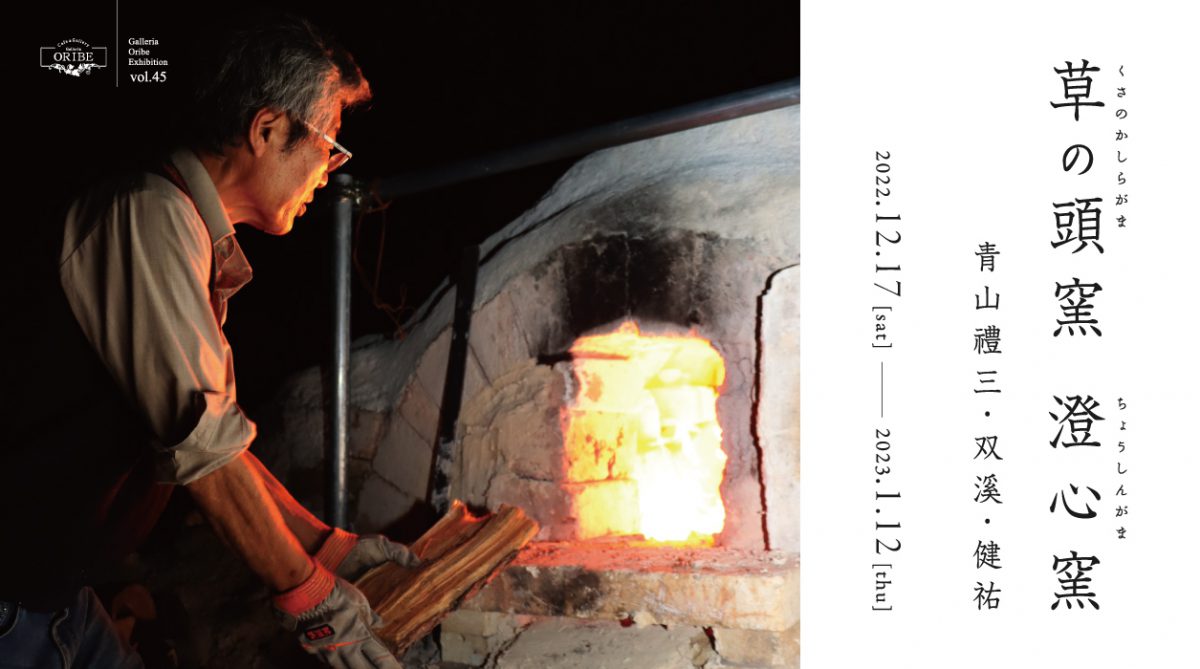青山双溪氏「白天目」の再現に挑んだ窯~日本語と英語でご紹介~
たじみDMO(一般社団法人 多治見市観光協会)では、合同会社Mimir(小名田町1-3-4)に委託し、多治見を紹介するコラム(Discover TAJIMI 英語版・日本語版)を執筆していただいています。今年度は3つのテーマで配信される予定ですが、2つ目のコラムが完成したのでご紹介します。
今回取り上げられているのは、多治見市無形文化財保持者で陶芸家の青山双溪さんの取り組みにについてです。

2022年12月のある日、僕は多治見市小名田町の自宅近くの裏山に登り、陶芸家の青山双溪氏に話を聞きに行きました。青山氏が建てた窯の横で日向ぼっこをしながら彼にたくさんのお話を伺いました。彼は室町時代の「白天目」(しろてんもく)と言われる茶碗を再現し、2018年に多治見市の無形文化財保持者に認定されています。その原点に立ち返るため、白天目が作られた室町時代(1336年~1573年)の窯をモデルに独自の窯を開いたのです。
One day in December 2022, I went up a hill near my house in Onada-cho, Tajimi City, to talk with potter Soukei Aoyama. While sitting in the sun next to the kiln that Aoyama had built, I listened to his many stories. He reproduced a Muromachi period (1336–1573) “Shiro tenmoku” (white tenmoku) tea bowl and was certified as an intangible cultural property holder by Tajimi City in 2018. To return to the origins of this ceramic tradition, he opened his own kiln, modelled after the kilns of the Muromachi period when Shiro-tenmoku was made.
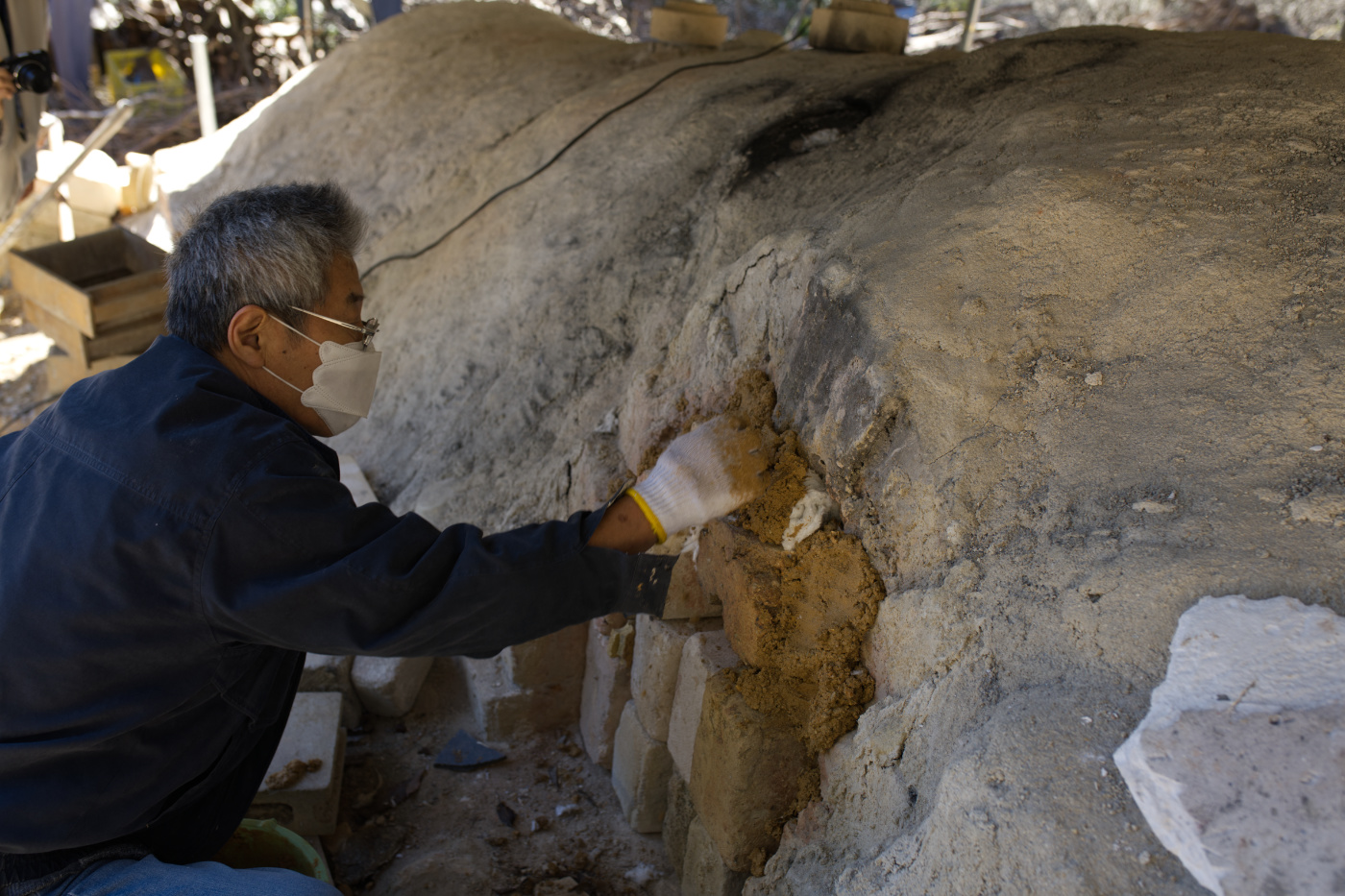
この日は窯焚きが終わって5日後で、その窯の大きなおなかのような部屋が冷め、中の陶器が取り出せるようになっていました。思い返してみればこの試みにはたくさんの苦労がありました。2年前、窯の建造に必要なレンガ作りから始まり、今回の窯焚きでは底冷えのする多治見の冬の夜に、陶芸家たちは眠気と戦いながら巨大な穴窯に薪をくべ続けました。こんなふうに最初から最後まで苦労の連続でした。僕は何か月も薪割りを手伝わせていただき、何トンもの薪を割ったのですが、窯焚きは想像以上に大変な作業で、実際に近くで見させてもらって分かったことがたくさんありました。
The large belly-like chamber of the kiln cooled down after the five-day firing was completed, allowing the pottery inside to be removed. This endeavour required a significant amount of effort. The potters fought sleepiness as they continued to firewood into the massive anagama kiln on cold winter nights in Tajimi. It’s been two years since the first kiln brick was produced. It has been a difficult journey from beginning to end. I was permitted to assist in the cutting and splitting of several tonnes of wood. Kiln firing is much more difficult than I had anticipated, and seeing it up close taught me a lot.
窯がある虎渓山町は、多治見駅からバスや自転車で簡単にアクセスできます。周辺には美味しい食べ物屋さんやカフェがあり、長い歴史のある永保寺からもそれほど遠くはありません。
ギャラリーやショップで目にする陶芸家たちの作った焼き物は、長い時間と手間のかかるプロセスの最終結果であり、特に薪窯の場合もっと多くの苦労の結晶なのですが、その過程はとても興味深く勉強させられることがたくさんあります。青山氏は生涯をかけてこの地方で作られた白天目の復元をしました。今回は2年前に窯を作るためのレンガ造りから始まり、何回ものテストを経て作った窯についての記事で、2022年11月29日から行われた初焼成の記録を記しました。
The kiln is located in Kokeisan-cho, which is easily accessible by bus or bicycle from Tajimi Station. There are some good restaurants and cafes in the area, and the Eihoji Zen Temple, which has a long history, is not far away. If you are interested, you can find more information at the end of this article.
The pottery you see in galleries and stores is the end result of a long and laborious process that is both fascinating and instructive, especially when it is the culmination of the hard work required for a wood fired kiln. Aoyama has spent a significant part of his life restoring the shiro-tenmoku made in this region. This article documents the first firing on November 29, 2022, in a project that began two years ago with the construction of bricks to build the kiln.
窯への装填と焼成 LOADING AND FIRING THE KILN
10日以上に渡って行われた窯焚きの概要は次の通りになります。
11月28~30日 November 28, 29, and 30
窯への陶器の積み込み
Loading of pottery into the kiln
12月1日 December 1
窯詰めは朝の6時に終了。窯を200度ぐらい低温で炙る。
Kiln loading ends at 6:00 a.m. The kiln is fired at a low temperature of about 200 degrees Celsius.
12月2日 December 2
この日の朝までに400度くらいに到達。その後750度前後までゆっくりと温度を上げ、その温度をキープ。
By the morning of this day, the temperature had reached about 400 degrees. The temperature was then slowly raised to around 750 degrees and held at that temperature.
12月3日 December 3
午後3時から強い還元をかけていく。還元の温度は約900度からスタート。最終的には1200度まで上昇させる。
A strong reduction is applied starting at 3:00 p.m. The temperature of the reduction starts at about 900 degrees. Eventually, the temperature is raised to 1,200 degrees.
12月4日 December 4
午後3時に「色見」を出して釉薬の様子を見たところ、灰釉は溶けてなく、染付も溶け不足のため、更に薪を焚いていく。
At 3:00 p.m., an iromi test sample is pulled out to see how the glaze is doing. The ash glaze is not dissolved, and the dye is not dissolved enough, so more wood is burned.
12月5日 December 5
午前10時頃鎮火。窯の冷却が始まる。
The fire was extinguished around 10:00 a.m. The kiln begins cooling.
12月10日 December 10
窯から陶器が取り出される。
The pottery is removed from the kiln.

青山氏は今回窯の中の酸素を少なくした状態で焼く、つまり還元焼成を予定しています。一酸化炭素は、空気で燃やせる量以上の燃料を入れると発生するガスで、温度を上げると素材から酸素を奪います。土や釉薬に含まれる酸素を奪うのです。その結果、陶器は独特の色合いになります。『還元焼成』は約900度からのスタートを想定していますが、窯がいうことを聞いてくれるのか心配です。
この焼成のために青山氏は50点あまりの白天目を含む約150点の陶器を、息子の健祐さんとともに窯内の棚に積み、詰めていきました。窯は斜面の下にある焚口から、ダンパーや煙突のある上部まで約7メートルもの長さになります。
2人の親子は、窯に火を入れる前の11月28日から積み込みを始め、終わったのは火入れ当日の朝6時だったそうです。さぞかし寒かったことでしょう。青山氏はその時のことを「イノシシが寄ってきて、鳴いていたんですよ!」と冗談めかして話しました(5日間に及ぶ窯焚きの間、イノシシが何度も様子を伺いに来ました)。12月1日の火入れの朝、数時間しか寝ていない健祐さんはすでに疲れきっている様子でしたが、いよいよ窯焚き本番です。
Master Aoyama uses reduction firing, that is, firing with less oxygen in the kiln. Carbon monoxide, a gas that is produced when more fuel is added than can be burned by air, deprives materials of oxygen when the temperature is raised. It robs oxygen from the clay and glaze. As a result, the pottery takes on a distinctive color. Reduction firing is supposed to start at about 900 degrees Celsius, but would the kiln behave as expected?
For this firing, Aoyama and his son, Kensuke, stacked and packed about 150 pieces of pottery, including about 50 pieces of Shiro tenmoku, on shelves inside the kiln. The kiln is about 7 meters long, from the firing box at the bottom of the slope to the top, where the damper and chimney are located.
Father and son began loading the kiln on November 28 and finished on December 1, the day of the firing. “A wild boar came up to us and was squealing!” Mr. Aoyama joked. Several times during the five days of kiln firing, the boars came to check on them. Kensuke, who had only slept a few hours the night before, appeared exhausted on the morning of the firing on December 1.
焼成が還元レベルに達するには、数日かかります。まず、窯の中の湿気を取り除かなければ釉薬が剝がれてしまいます。火おこしのため健祐さんが山腹の薪から細い枝を集め始め、火をつけようとしていました。枝は数日前の雨でべちゃべちゃに濡れていて、少し苦労したように見えましたが、なんとかうまく火が点きました。窯焚きの初日は湿った内部を乾燥させるために、窯の温度を低く一定に保つようにしました。
The firing takes several days to reach the reduction level. First, the kiln’s moisture must be removed, or the glaze will peel.Kensuke began gathering thin branches from the wood on the hillside and was about to light the fire. The branches were moistened from the rain earlier in the autumn, and it looked as if he was having a little trouble getting the fire started, but he managed to light it successfully. On the first day of firing, the potters tried to keep the kiln temperature low and constant in order to dry out the dampness from the pottery and their enguro cases. Firing is not a matter of raising the temperature all at once; it is necessary to raise the temperature in stages. After searing the kiln at a low temperature of about 100 to 200 degrees, more wood is added, and the temperature is raised to about 750 degrees. Then that temperature is maintained. “This is what we call ‘pulling the fire,’ ” Aoyama explained. We need to keep the temperature flat.
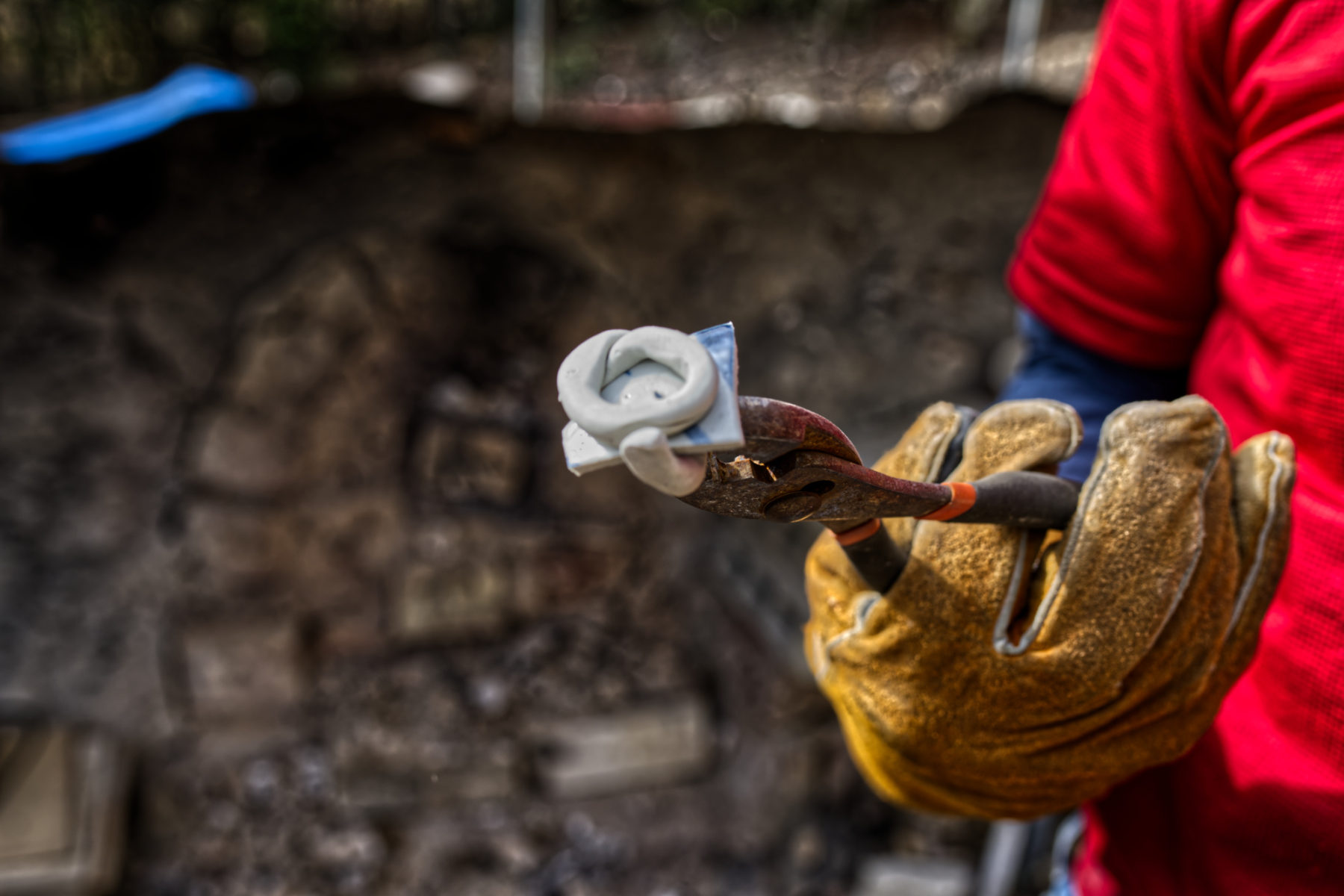
焼成は一気に温度を上げればいいというものではなく、段階的に温度を上げる必要があります。窯を100~200度くらいの低温で炙った後、さらに薪を投入し750度くらいまで温度を上げます。そしてその温度を維持するのです。「これが火を引っ張るということです」と青山氏は説明しました。温度を横ばいにする必要があるのです。
そして4日目、1200度の還元焼成温度まで加熱しました。陶器の種類によってその反応はそれぞれ違います。例えば灰釉の焼き物は、他の作品よりも長い焼成時間を必要とします。青山氏は瀬戸黒の作品が先に焼きあがると説明します。「他の物より先に瀬戸黒のサンプルを先に取り出します。それから上は下のほうより暖かいんです。例えば下の方の作品を取り出して釉薬がちゃんと溶けているように見えたら、上の層の作品は取り出しても大丈夫だと分かりますよね。だから下の方の作品に目を配り、工程の進み具合やその色などで火加減を調整しています」また彼が言うには『色見』と呼ばれる小さなサンプルを使い、簡単に取り出して釉薬の状態を確認するのだそうです。
Then, on the fourth day, the kiln was heated to a reduction firing temperature of 1,200 degrees Celsius. Each type of pottery reacts differently to this process. Ash-glazed pottery, for example, requires a much longer firing time than other pieces. Aoyama says that Seto-guro (Black Seto) pieces are done first.
“We take a sample of the Seto-guro first, before the others,” he says. The kiln is hotter under the ceiling than on the floor. For example, if you take a piece from the bottom and the glaze looks like it’s melting properly, you know it’s safe to take the piece from the top layer. “So I keep an eye on the pieces on the bottom and adjust the heat according to how the process is going and the colour of the piece.” He also uses small samples, called “iromi,” which he can easily take out to check the condition of the glaze.
彼が窯の戸を開け、初めて中の火を見ることができました。火は現在フル稼働しています。正直なところ燃え盛る炎を想像していたのですが実際は全く違いました。今まで見たこともないような、熱いオレンジ色の液体が何層にも重なっているような、ゆっくりとした動きをしているのです。猛烈に熱いはずなのに、不思議と自分がいるところからはあまり熱さを感じませんでした。
He opened the door of the kiln, and we were allowed to see the fire inside for the first time. The fire was now at full blast. To be honest, I had imagined a blazing inferno, but the reality was quite different. It was like nothing I had ever seen before: a slow-moving, multi-layered, hot orange liquid. It should have been intensely hot, but strangely, I didn’t feel much heat from where I was.
現代に大名物として美術館などに納められている白天目は、500年前から武士が使ったりして大切に伝わってきた作品です。その中の一つは武野紹鴎(1502年~1555年)が初めて注目したとされています。今回青山氏が窯で焼き上げる白天目は、現存する大名物とほとんど見分けがつかなくなるのでは!と期待が高まりますがどうなるのでしょうか。今回は、小名田町の白山神社境内で見つかった破片に含まれていた土に近いものを使用したそうです。
The Shiro tenmoku, which are housed in museums and other places today as great masterpieces, have been carefully handed down for 500 years and were used by warriors and others in the societal elite. One of them, Takeno Joo (1502-1555), is said to have first highlighted the beauty of Shiro tenmoku tea bowls. The bowls that Aoyama is firing in his kiln this time may turn out to be almost indistinguishable from the existing great masterpieces! This time, he used a clay similar to that found in the Shiro tenmoku shards found in the precincts of Hakusan Shrine in Onada Town.
結果について ABOUT THE RESULTS

火を止めてから5日目です。坂道を登って窯を訪ねると、すでに大勢の人が集まっていました。青と白のストライプの運動着を着た学生たちもたくさん来ています。窯を開ける瞬間を写真におさめようタブレットやカメラを用意してきたのだそうです。ちょうど青山氏が窯横の入口を開けるため、口を塞いでいるレンガを取り出そうとしているところでした。白天目は予定通りうまく焼きあがったのでしょうか。ここまで窯の準備には相当な時間がかかっています。この20年間彼は白天目とその工程を再現するために心血注いできました。ここまでの工程を目の当たりにしてきた全員の胸に様々な思いが浮かび、会場は興奮に包まれていました。
しばらくすると青山氏が入口のレンガを外し中の棚から最初の作品を取り出し始めました。背の高い花器や酒器、染付など、さまざまな種類の焼き物が並んでいるのが見えます。中には棚に張り付いてしまったものもあったようですが、全体としては問題ないようです。今度の展覧会では、この中から彼が厳選した作品を展示するとのことです。白天目の出来は気になりますが、まだ取り出されていません。
It is the fifth day since the fire was shut down. When I climbed the hill to visit the kiln, many people had already gathered. Many students in blue and white striped sports uniforms were also there. They had prepared tablets and cameras to capture the moment of opening the kiln. Mr. Aoyama was just about to remove the bricks blocking the entrance next to the kiln in order to open it. Did the tea bowls come out right?
It has taken a lot of time to prepare the kiln so far. For the past 20 years, the master has devoted himself to reproducing Shiro tenmoku and its process. The venue was filled with excitement as various thoughts came to the hearts of everyone who had witnessed the process up to this point. After a while, Mr. Aoyama removed the bricks from the entrance and began to take out the first pieces from the shelves inside.
Tall vases, sake vessels, and some underglaze white and blue pottery, among many other types of pottery, could be seen. Some of the pieces seemed to have stuck to the shelves, but overall they look fine. Aoyama has carefully chosen a number of these pieces to show at the upcoming exhibition.I’m interested to see how the Shiro tenmoku turned out, but they haven’t been taken out yet.
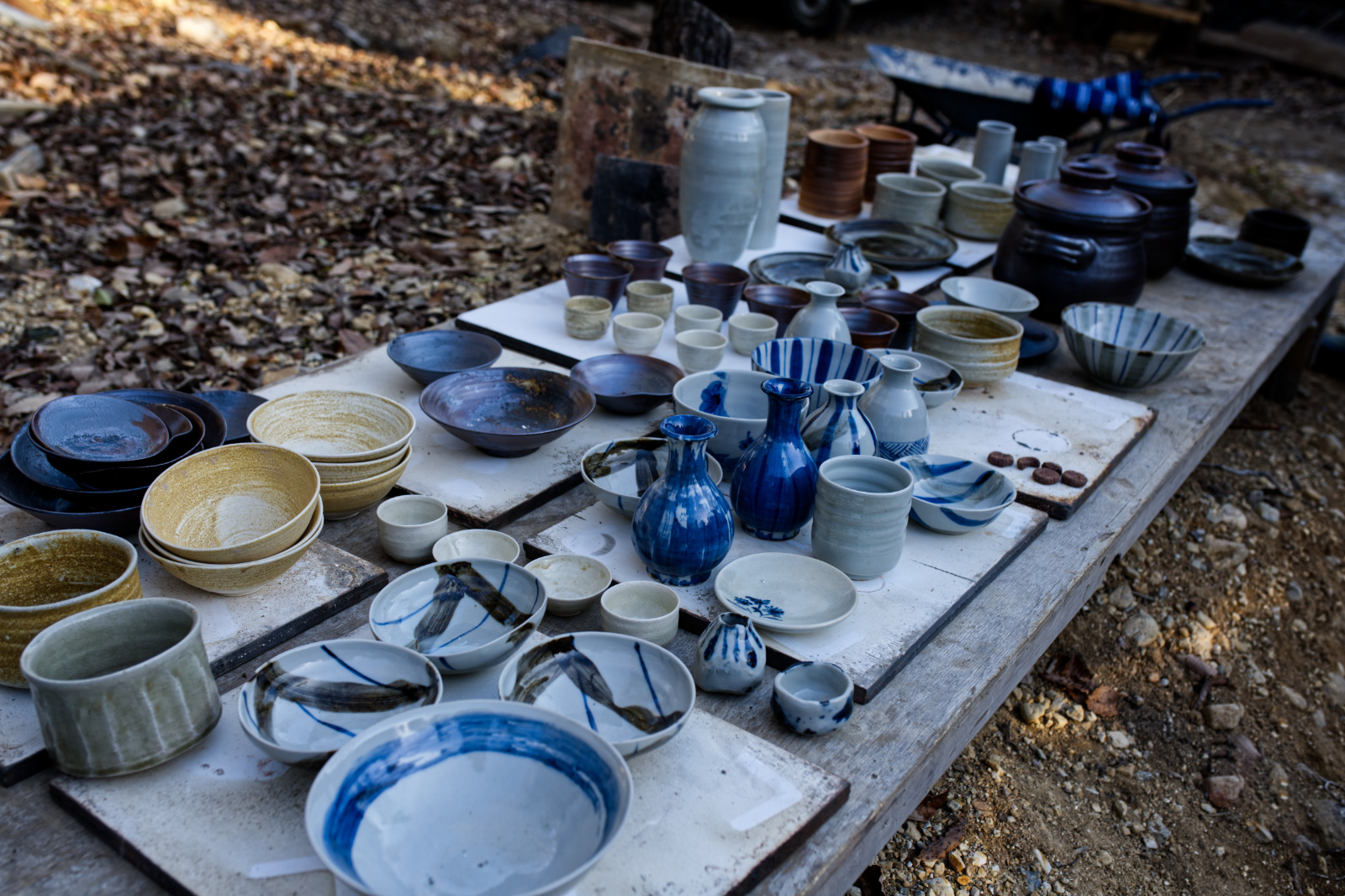
そして息をのむ瞬間です……。「残念ながら、白天目と言われる色が出たものは一つもありませんでした。茶碗の底の緑色の釉薬が、深みのある緑色になっていませんね」と青山氏は天目茶碗を取り出し批評しました。そしてその違いを見せるために、古窯から発掘された碗の破片を焼きあがった天目茶碗の底に置きました。「釉薬の気泡はあるのですが、色が違います」と話しながら続けます。「この茶碗は質が悪い、それは土のせいだと思われます。私が使っている土よりも純度が低いようです。それと酸化鉄分などの物質が足りないですね」
It’s a breathtaking moment.Unfortunately, there was not a single piece that had the colouring of classic Shiro tenmoku. The green glaze on the bottom of the bowl has not turned a deep green color. Mr. Aoyama took out a tenmoku tea bowl and scrutinized it. To show the difference, he placed a piece of a bowl excavated from an old kiln on the bottom of the finished bowl. “There are bubbles in the glaze like in the old shard, but the colour is different,” he said. “This bowl is of poor quality, and I suspect it is due to the clay.” It seems to be less pure than the clay I use. Also, it contains too little of certain substances, such as iron oxide.”
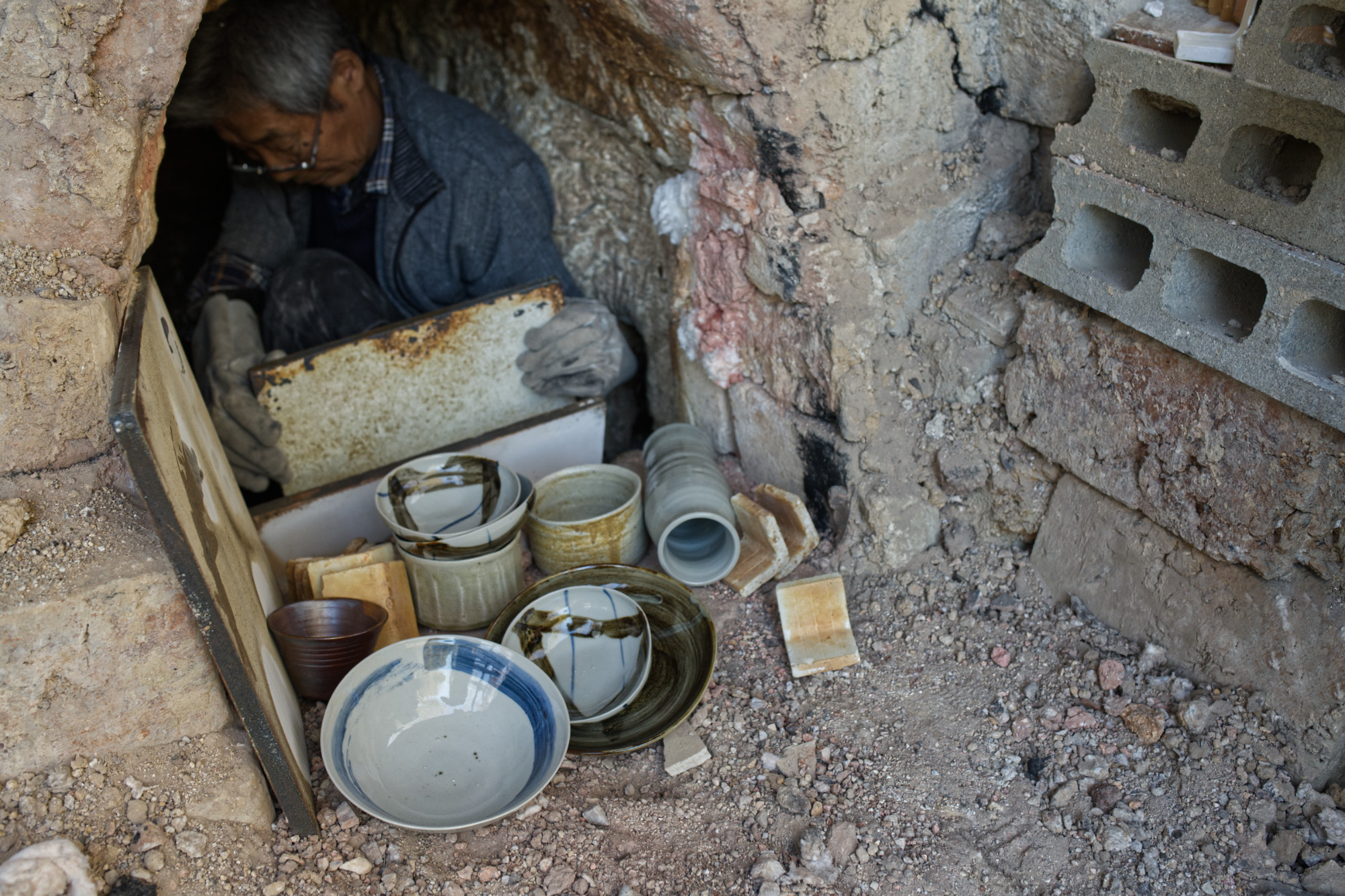
鉄分など一部の物質が足りない ということで青山氏の研究はまだ終了ではありません。「最適な土の場所はどこか?白天目はこのあたりで作られたものだから、この狭い範囲にあるはずなんです」と彼が話したので、僕は「もう少し鉄を混ぜられないの?」と尋ねてみました。彼はこう続けます。「いや、そういうわけにはいかないんです」「室町時代の陶工たちに電話して聞いてみたいですね」と僕は冗談を言ったら、彼は「いや、半世紀も経てば、土地もずいぶん変わっていますよ」と言って笑いました。
窯の中では何が起きていたのでしょう。青山氏曰く、右側では案の定還元が起こり、左側では逆に酸化が起こったそうです。困りましたね。窯の設計といい、器の原料の調合といい、さらなる工夫が必要なようです。「まだまだですが自分が正しい道を歩んでいることは分かっています。この長い旅もあと数歩ですが、最後の一歩が一番辛い。 そして今本当に疲れています」
青山氏が疲れているのは間違いないですね。この時彼は窯の煙突の横の日当たりの良い場所で、話している間に眠ってしまったのですから……。確かに山で3泊4日は睡眠不足ですね。
Aoyama’s research is not over yet. “Where is the optimal soil?” he wonders. “Shiro tenmoku was made in this area, so it has to be somewhere around here.” “Can’t you mix in a little more iron?” I ask. “No, it doesn’t work like that.” “Maybe we can make a phone call back to the potters of the Muromachi period and ask them.” I joke. “No, the land has changed a lot in the last 500 years,” he replies with a laugh.
What was going on inside the kiln? According to Mr. Aoyama, reduction occurred on the right side of the kiln and oxidation on the left side. That was a problem. It seems that he needs further ingenuity in the design of the kiln and in the preparation of the raw materials for the vessels. “I am not there yet, but I know I am on the right path. “I have only a few steps left in this long journey, but the last step is the hardest.” “And now I am really …tired…”
The master dozed off as we chatted in the warm sunshine by the kiln’s chimney. Four days and three nights of working in the mountain must be exhausting.
アクセス
草の頭窯(KUSANOKASHIRAGAMA KILN)
青山氏の「草の頭窯」は、虎渓山町の隣の小名田町にあります。こちらにはギャラリーも併設されています。今回の記事の薪窯は「虎渓山 澄心窯」と名付けられ、草の頭窯とは別の場所にあります。
Master Aoyama’s kiln, Kusanokashiragama, is located in Onada, a neighboring village to Kokeisan village, where the Choshingama is located.
虎渓山 澄心窯(THE CHOSHINGAMA KILN)
この記事を書いている時点では、窯に続く道はまだ地図に記されていませんでした。しかし、まず近くにあるサンドールというカフェに行けば、簡単に窯を見つけることができるでしょう。カフェの左側の道を登っていくと、砂利道に突き当たります。その砂利道を200メートルほど登ると、虎渓山 澄心窯が見えてきます。
The road leading up to the kiln was not yet marked on the map at the time of this writing. However, you will easily find the kiln by first going to the cafe nearby called Sandor. Walk up the road to the left of the cafe, and it will end up in a gravel road. Continue on the gravel road up the hill for about two hundred meters and you will find the Choshingama kiln.
最後になりますが、青山双溪さん、青山健祐さんは、現在ガレリア織部にて展覧会を開催されています。ぜひお出かけください。
■草の頭窯 澄心窯 —青山禮三・双溪・健祐—
【会期】2022年12月17日(土)~2023年1月12日(木)
【時間】10:00~17:30
【場所・主催】ガレリア織部(白山町2-222)
【入館料】無料
※詳細はこちらをご覧ください
507-0004
小名田町4-3
TEL 0572-22-2950
MAIL k-kasira@ob.aitai.ne.jp
https://www.kusanokashiragama.com/


